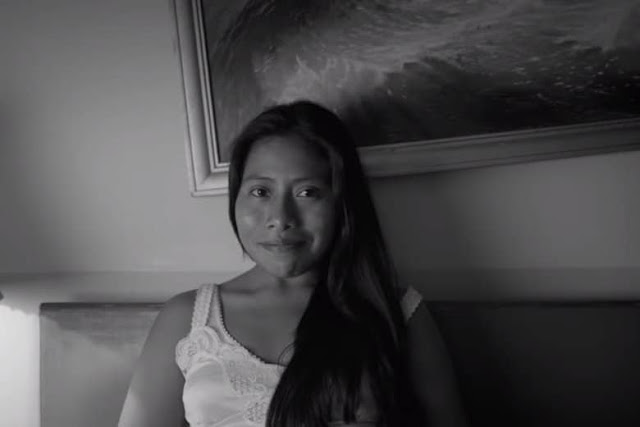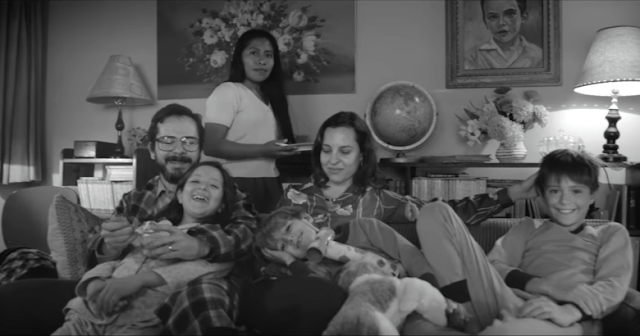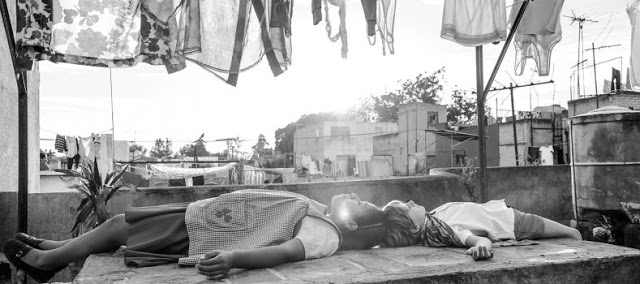Early in Alfonso Cuarón’s Gravity, two astronauts frantically attempt to propel themselves back to a docking station by way of a jetpack, their tiny white suits looking like stars that dot the infinite blackness of space. Early in Roma, Cuarón’s new film for Netflix, a man slowly pulls his car into a narrow garage, repeatedly rotating his wheels and pulling in his mirrors to avoid scraping the walls. As parking jobs go, the stakes here are rather less severe, given that the man is seeking to avoid minor property damage rather than trying to cheat death; it’s a scene about a Ford Galaxie, not, you know, the galaxy. But Cuarón’s camera captures the process with the same spooky intimacy, locking on the sedan’s boxy corners and bulky wheels as they swivel to and fro, searching for safety. The director’s craftsmanship never wavers, whether he’s chronicling explorers careening into space or cars rolling over dog shit.
In empirical terms, Roma is a smaller film than Gravity, Children of Men, or Harry Potter and the Prisoner of Azkaban; it doesn’t make heavy use of thriller tropes or special effects, and it doesn’t take place in dystopian or fantastical worlds where humanity’s very survival is at risk. But it shares with those movies a certain philosophical principle, the persistent belief that cinema is a tool for telling thorny, personal stories on a grand scale. In some ways, Roma is a low-key family drama, but if its narrative occasionally verges on mundane, its technique is never less than extraordinary.
About that family: It’s headed by a handsome doctor, Antonio (Fernando Grediaga), and his wife, Sofia (Marina de Tavira), who are raising four adorable young children. None of them, however, is the film’s protagonist; instead, Roma focuses on their maid, Cleo (Yalitza Aparicio, achingly tentative), and while she isn’t technically a member of the family, it’s difficult to imagine them surviving without her. Along with a fellow helper, Adela (Nancy García), Cleo essentially runs Antonio and Sofia’s roomy, nicely upholstered home: cooking meals, washing dishes, scrubbing floors, doing laundry, and even tucking in and waking up the kids. She is a servant of the household and is also, in some ways, its quietly invisible master.
In structuring Roma as a meandering, observational, largely plotless character study, Cuarón has chosen to convey meaning through mood and tempo rather than traditional storytelling beats. It’s an ambitious approach (you were expecting something else?) that doesn’t always pay off, especially during the movie’s sluggish first hour. Cleo is a compelling and sympathetic figure, winningly played by Aparicio, but while Cuarón capably details the breadth of her servile duties, his impeccable mise-en-scène doesn’t render those duties especially interesting. Of course, that’s partly the point; as a low-wage earner in 1970s Mexico, Cleo’s upward mobility is limited, and Roma captures how she silently manages her expectations, taking pleasure in fleeting moments of freedom—she spends her sporadic off-hours going to the pictures, eating ice cream, and seeing her martial-artist boyfriend, Fermín (Jorge Antonio Guerrero)—while always cognizant that her livelihood hinges on keeping her employer happy. (The children may love Cleo just as much as they love their actual mother, but as Cleo comprehends all too easily, Sofia can’t be fired on impulse.) All the same, the leisurely pacing can feel oppressive, placing you, the hungry viewer, in the awkward position of waiting for something to happen. Roma is entirely true to life, but sometimes, real life can feel an awful lot like boredom.
Thankfully, even if your stomach is growling, your eye can feast on Cuarón’s exceptional craft, which is somehow both soothingly naturalistic and incredibly precise. Serving as his own cinematographer and shooting in 65-millimeter digital, he arranges every frame with astonishing rigor, giving the widescreen, black-and-white image exquisite sweep and texture. Yet where an aesthete like Wes Anderson has often (unjustly) been charged with inordinate fussiness, Cuarón lets his pictures breathe, his camera gliding purposefully across a room without ever feeling rushed. The result is a rich, enveloping experience that is, with due respect to Annihilation and The Favourite, the most visually stunning film of 2018.
Though he’s initially content to passively monitor the humdrum rhythms of Cleo’s day-to-day life, Cuarón eventually takes a firmer hand with his narrative, quickening the story’s pace and gently goosing its drama. And at around its halfway point, Roma starts sharpening into something more urgent and rewarding, its elliptical plot catching up with its lapidary visuals. Recalling To Live, Zhang Yimou’s spectacular movie about a family reckoning with the seismic changes of post-war China, Roma treats history as its backdrop rather than its subject, foregrounding its characters against the ugliness of the Mexican Dirty War. A handful of scenes—a vacation to a sprawling hacienda where a fire breaks out, a visit to a paramilitary group’s training regimen, a peaceful protest that suddenly shifts into a bloodbath—hint at the unrest sweeping the nation, but Cuarón has no interest in making an informational docudrama. He instead seeks to tell a keen, poignant story about a woman trying to make her way in a world that regards her as disposable.
She isn’t the only victim. We gradually learn that Sofia, whose aging mother (Verónica García) also lives with them, has problems of her own. And with little fanfare, Cuarón quietly creates a nuanced relationship between Cleo and Sofia, a complex codependency that defies easy labeling. Sofia seems to be a nice enough boss, and she treats Cleo with decency and respect. But she also unconsciously enforces the hierarchy of homeowner and maid, and Cleo regards her with fear as well as empathy and admiration. A scene where Cleo tearfully asks Sofia if she’s going to be fired proves heartwarming, but it also illuminates the social strictures that conspire to oppress the working poor and make them subject to the whims of their superiors.
That’s an important message, but Roma is by no means a message movie. To the contrary, in its second half it becomes something of a set-piece machine, pummeling you with one audacious sequence after another, yet always retaining an intense and sympathetic focus on its characters. And so, the Corpus Christi Massacre is glimpsed from the point of view of customers in a department store, idly shopping for goods before suddenly being confronted with violence and terror. A scene of a baby being delivered is agonizingly suspenseful, but it’s most notable for its unnerving silence, its lack of histrionics. And a late trip to the beach flips from sunny to scary in a flash, the waves crashing down with metrical, pitiless force. Cuarón masterfully lets these moments unfold via long, fluid takes, heightening their power not through chaotic showmanship, but through beauty.
Watching these astonishing scenes, it’s easy to see why so many critics have hailed Roma as a masterpiece. I can’t go quite that far. The movie is singularly impressive, yes, but it’s too slow and distant in parts for me to fully embrace it. But even at its most challenging, Roma is a massive achievement, boldly marrying intimate storytelling with a filmmaking style that’s simultaneously muscular and elegant. Cuarón doesn’t need spaceships to reach new heights.
Grade: B+
Jeremy Beck is the editor-in-chief of MovieManifesto. He watches more movies and television than he probably should.




